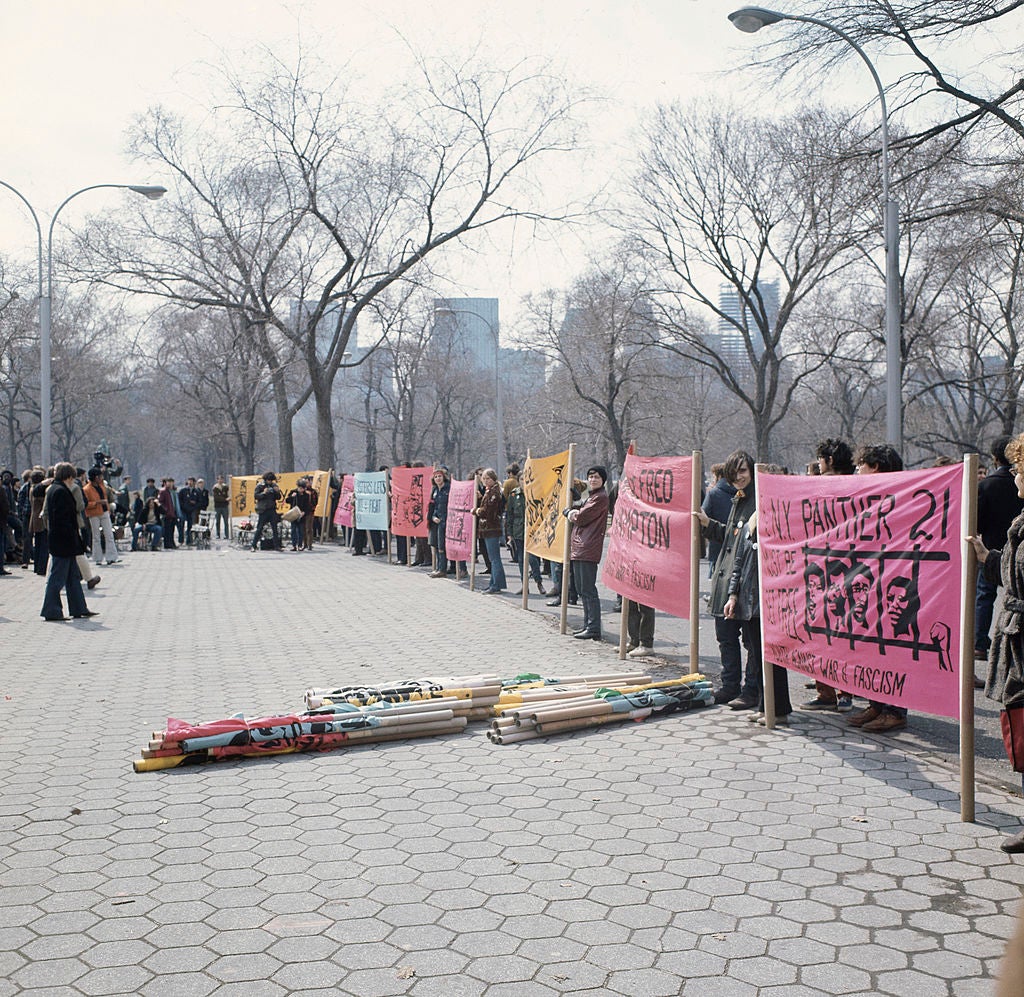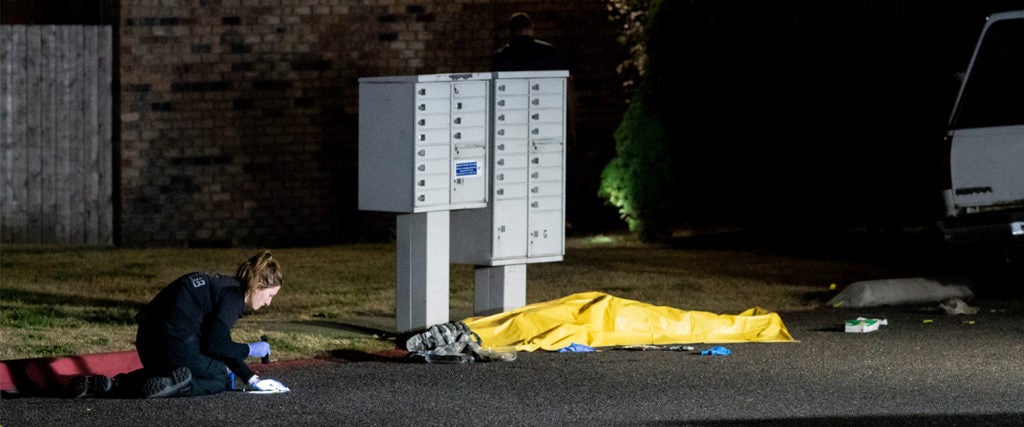On December 4, 1969, under cover of predawn darkness, 14 police officers gathered at the base of Fred Hampton’s home in Chicago. Two squads covered the front and rear entrances of the two-story building at 2337 W. Monroe Street. Shortly after 4:30 a.m., the officers kicked down the door.
Hampton’s bodyguard and friend Mark Clark was dozing off in the front room, sitting in a chair with a shotgun in his lap. He took the first bullets in the chest, dying instantly. The officers flooded into the dark home, opening fire in every direction. Over the course of only a few minutes, they unloaded more than 80 shots.
The police claimed that Clark had fired his shotgun through the door first, and that Hampton had inadvertently taken shots in the ensuing scrum. But Hampton’s fianceé, Deborah Johnson, and the four other Black Panthers in the room who survived the raid were resolute about what they saw: Police executing an injured Hampton with two bullets to the skull, then turning their guns to the adjacent bedroom and pulling the trigger with indiscriminate rage.
And just like that, the chairman of the Illinois chapter of the Black Panther Party, and a key organizer in coalitions all across Chicago, was no more. The FBI had been surveilling him for years despite no solid evidence of criminal activity. Now, under guise of a search warrant for illegal weapons, the state had carried out an execution.

I couldn’t help but think of Hampton while reading the news about the police killing of Michael Forest Reinoehl, the man who shot and killed a right-wing protester in Portland as part of a Trump rally. Multiple cameras captured that August 30th shooting, which unfolded with little fanfare on a dim sidewalk outside of a downtown parking structure. Reinoehl, 48, was an Army veteran and father of two who frequently joined the front lines of the unceasing protests against police and federal agents. He identified as an antifa supporter, and claimed that he only pulled the trigger against his victim, Aaron Danielson, after the latter threatened violence.
“There was definitely nobody in sight, no police officer, nobody at all that could intervene. It was a free-for-all. And the police were letting it happen,” he told Vice after the shooting.
The reality of what happened that night remains much murkier. Videos of the incident caught voices saying “we’ve got two here” shortly before the encounter, which could’ve been uttered by either Reinoehl and the man he was walking with, or Danielson (a supporter of the right-wing group Patriot Prayer) and the man he was walking with. Analyses by the Seattle Times and the New York Times noted that Danielson raises a canister of bear mace at Reinoehl before we hear two quick pops of a pistol. But security cameras also show Reinoehl noticing the two men and looping back to follow them shortly before the encounter — a point that has made right-wing commentators conclude that Reinoehl was a far-left killer hunting a Trump supporter to instigate and kill.
Whatever happened on August 30th, it only took authorities three days to find Reinoehl in the small town of Lacey, Washington, 100 miles from Portland. They had a warrant for his arrest, but that never happened — instead, two unmarked cars rushed him as he walked to his car, and four federal and local officers quickly shot him to death in a massive volley of gunfire. Bullets blew the window of a nearby car and ended up embedded in a nearby resident’s kitchen wall. Investigators have found no evidence that Reinoehl shot the pistol he was carrying at the time, despite police initially claiming that he pulled a gun and shot first. And this week, an eyewitness came forward to affirm that Reinoehl didn’t reach for his pistol, adding that the agents never identified themselves — nor order Reinoehl to get down and surrender.
There are few comparisons to make between Hampton and Reinoehl as activists; one was a powerful Black community leader, while the latter was a white man who seemed fatally attracted to seeking out fights at protests. The former never committed a violent crime; Reinoehl shot and killed a man for questionable reasons. But their identities as leftist “radicals” directly led to their deaths at the hands of the state, adding to a gnarled lineage of American law enforcement executing controversial figures with little recourse.
The FBI and Chicago police feared and hated the Black Panthers and Hampton, believing him to be the speartip of a rising anti-white revolution. Similarly, there is no greater bogeyman to the Blue Lives Matter crowd than antifa, and the rhetoric isn’t just spread on right-wing forums and white supremacist Facebook groups — it’s spread by law enforcement themselves, whether it’s breathless reports of an antifa “caravan” hitting police bulletin boards or an outlet like Law Enforcement Today publishing false rumors about antifa arsonists setting the fires that are ravaging the West Coast.
While public officials in Oregon are pleading with the public to stop sharing rumors and misinformation about supposed antifa arson attacks, a misleading article by Law Enforcement Today backing that narrative is going viral on Facebook. pic.twitter.com/UWdFJLzL0V
— Julia Carrie Wong (@juliacarriew) September 10, 2020
We were approached by an armed group telling us to leave, they are wary of outsiders based on rumors of arsonists starting fires in the area. #OregonFires2020 #OregonFires #oregonwildfires pic.twitter.com/pbUJPC5hKh
— Justin Yau (@PDocumentarians) September 10, 2020
Given this state of affairs, is it really surprising that a squad of trigger-happy, under-trained police let loose their bullets against a man who, in the right-wing narrative so many cops love, stalked and murdered an innocent man in cold blood?
More and more frequently, law enforcement have proven in 2020 that they’re willing to take sides when it comes to policing the civil unrest and violence unfolding on our streets. One parallel is obvious: Just a week before Reinoehl’s killing, police were able to peacefully detain Kyle Rittenhouse, the teenager who drove across state lines and murdered two protesters in Kenosha, Wisconsin… also while claiming “self defense.” (It’s creepy to know that Rittenhouse was thanked by police for his support in the moments before his murders, rather than surveilled as a potential violent threat.)
But elsewhere, police have stood around twiddling their thumbs as armed protestors stormed the Michigan capitol and committed drive-bys with paintball guns, while still busting out the riot gear at the merest whiff of Black Lives Matter actions. On June 15th, a right-wing agitator assaulted three young women at an Albuquerque protest, then shot another person with a gun he was carrying illegally; he was arrested without incident, and an investigation found local police failed to secure key eyewitness accounts in the aftermath. More recently, in San Francisco, police prevented counter-protesters from engaging a Trump rally that blocked the Golden Gate Bridge, with witnesses claiming that people of color, and anyone wearing a “Black Lives Matter” T-shirt, were stopped under the threat of arrest.
The moral dilemma here isn’t whether Reinoehl deserved punishment or not. It’s whether our justice system can actually uphold the principle that people are innocent until proven guilty. Reinoehl is hardly the first person to be unjustly executed before their time in court; Jacob Blake, Breonna Taylor, and George Floyd, among countless others, have already proven that. But his killing is a dark reminder how different ideologies lead to different outcomes when police are first responders.
Reinoehl told Vice that he wasn’t going to turn himself in because he believed police and right-wing protesters were all out to “hunt” him, and that he would never see real justice. It was paranoia, but also a major premonition, unless you’re ready to believe four cops who weren’t wearing body cams and claim the opposite of witnesses. So much time, money and debate has been spent trying to reform policing, yet at the end of the day, the case comes down to gunshots, bloodshed and fingers pointing in opposite directions.
America couldn’t decide what truly happened to Fred Hampton without taking sides, and it’s the same story with Reinoehl in 2020, despite their huge differences and eras. What we know for sure is that this violent unrest is only growing as we near November — and police will continue to have outsized power on who ends up in cuffs, and who lands in the morgue.

